Xiaobin Guan
A Mechanism-Learning Deeply Coupled Model for Remote Sensing Retrieval of Global Land Surface Temperature
Apr 10, 2025Abstract:Land surface temperature (LST) retrieval from remote sensing data is pivotal for analyzing climate processes and surface energy budgets. However, LST retrieval is an ill-posed inverse problem, which becomes particularly severe when only a single band is available. In this paper, we propose a deeply coupled framework integrating mechanistic modeling and machine learning to enhance the accuracy and generalizability of single-channel LST retrieval. Training samples are generated using a physically-based radiative transfer model and a global collection of 5810 atmospheric profiles. A physics-informed machine learning framework is proposed to systematically incorporate the first principles from classical physical inversion models into the learning workflow, with optimization constrained by radiative transfer equations. Global validation demonstrated a 30% reduction in root-mean-square error versus standalone methods. Under extreme humidity, the mean absolute error decreased from 4.87 K to 2.29 K (53% improvement). Continental-scale tests across five continents confirmed the superior generalizability of this model.
Adaptive Regularized Low-Rank Tensor Decomposition for Hyperspectral Image Denoising and Destriping
Jan 11, 2024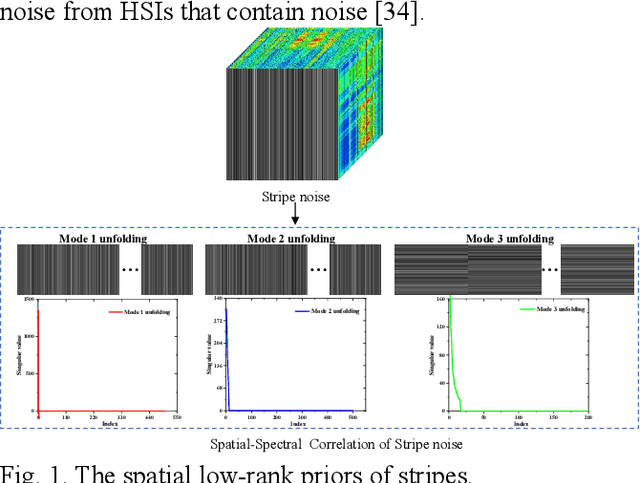

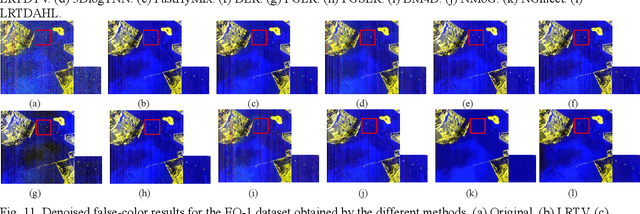
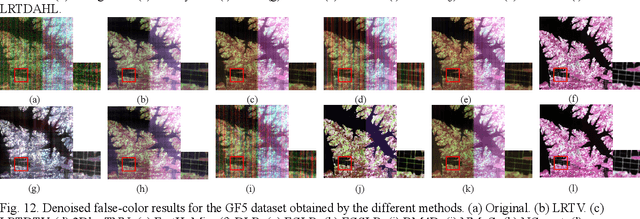
Abstract:Hyperspectral images (HSIs) are inevitably degraded by a mixture of various types of noise, such as Gaussian noise, impulse noise, stripe noise, and dead pixels, which greatly limits the subsequent applications. Although various denoising methods have already been developed, accurately recovering the spatial-spectral structure of HSIs remains a challenging problem to be addressed. Furthermore, serious stripe noise, which is common in real HSIs, is still not fully separated by the previous models. In this paper, we propose an adaptive hyperLaplacian regularized low-rank tensor decomposition (LRTDAHL) method for HSI denoising and destriping. On the one hand, the stripe noise is separately modeled by the tensor decomposition, which can effectively encode the spatial-spectral correlation of the stripe noise. On the other hand, adaptive hyper-Laplacian spatial-spectral regularization is introduced to represent the distribution structure of different HSI gradient data by adaptively estimating the optimal hyper-Laplacian parameter, which can reduce the spatial information loss and over-smoothing caused by the previous total variation regularization. The proposed model is solved using the alternating direction method of multipliers (ADMM) algorithm. Extensive simulation and real-data experiments all demonstrate the effectiveness and superiority of the proposed method.
Long time-series NDVI reconstruction in cloud-prone regions via spatio-temporal tensor completion
Feb 04, 2021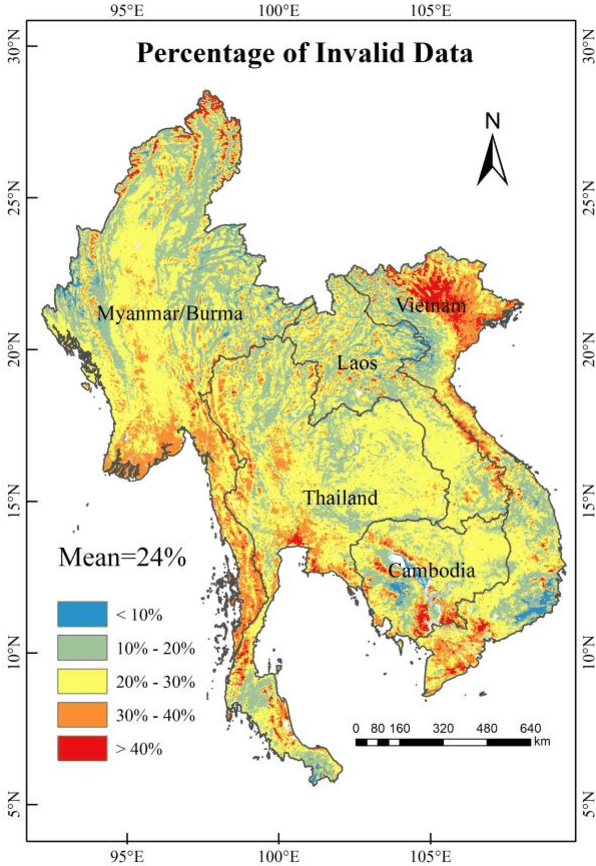

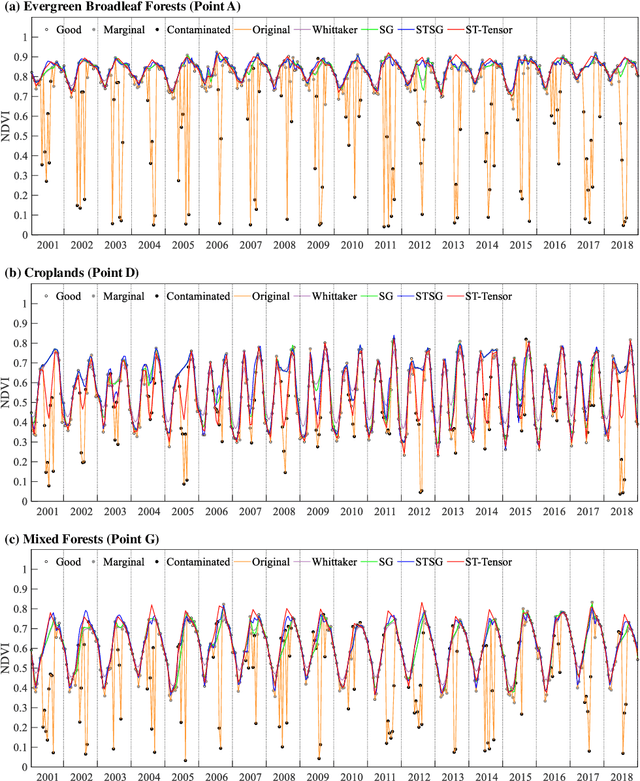
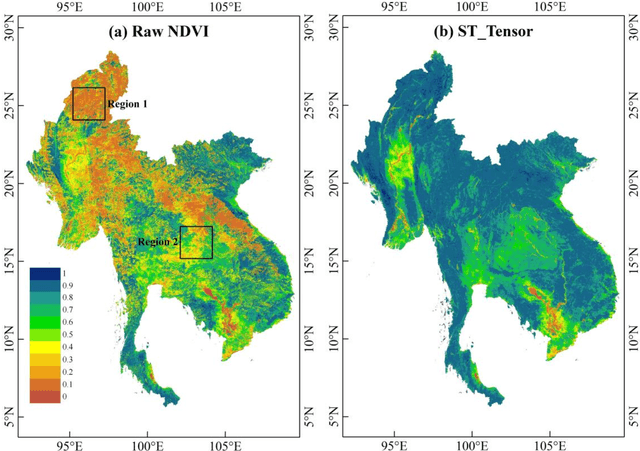
Abstract:The applications of Normalized Difference Vegetation Index (NDVI) time-series data are inevitably hampered by cloud-induced gaps and noise. Although numerous reconstruction methods have been developed, they have not effectively addressed the issues associated with large gaps in the time series over cloudy and rainy regions, due to the insufficient utilization of the spatial and temporal correlations. In this paper, an adaptive Spatio-Temporal Tensor Completion method (termed ST-Tensor) method is proposed to reconstruct long-term NDVI time series in cloud-prone regions, by making full use of the multi-dimensional spatio-temporal information simultaneously. For this purpose, a highly-correlated tensor is built by considering the correlations among the spatial neighbors, inter-annual variations, and periodic characteristics, in order to reconstruct the missing information via an adaptive-weighted low-rank tensor completion model. An iterative l1 trend filtering method is then implemented to eliminate the residual temporal noise. This new method was tested using MODIS 16-day composite NDVI products from 2001 to 2018 obtained in the region of Mainland Southeast Asia, where the rainy climate commonly induces large gaps and noise in the data. The qualitative and quantitative results indicate that the ST-Tensor method is more effective than the five previous methods in addressing the different missing data problems, especially the temporally continuous gaps and spatio-temporally continuous gaps. It is also shown that the ST-Tensor method performs better than the other methods in tracking NDVI seasonal trajectories, and is therefore a superior option for generating high-quality long-term NDVI time series for cloud-prone regions.
 Add to Chrome
Add to Chrome Add to Firefox
Add to Firefox Add to Edge
Add to Edge